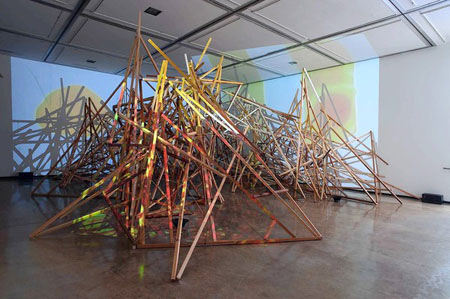
 Steve Roden, "Bowrain," 2010, mixed media, from his exhibition "When Words Become Forms," at Pomona College. Photo: Robert Wedemeyer / Pomona College Museum
Steve Roden, "Bowrain," 2010, mixed media, from his exhibition "When Words Become Forms," at Pomona College. Photo: Robert Wedemeyer / Pomona College Museum
Process and practice have been central to what visual artists do for a long time. It's easy to forget that until about a century ago technique in the service of an established cannon of officially approved subjects was normative. There was a reason the avant garde was synonymous with radicalism. In the half century that linked Impressionism to Dada and Surrealism a series of avant garde movements were overwhelmingly regarded with ridicule and hostility. The infrastructure of market and critical support was virtually non-existent. It's easy to romanticize a glamour that, with very rare exception, was not present.
The view that how an artwork came into being, and the companion notion that the personal coherence of an artist's body of work was important, was not a topic of consideration prior to those early avant garde movements. Similarly, prior to the Italian Renaissance the proposition that an artist be judged based on the individual nature of their thought and achievement, that the very name of an artist should be linked to their work and their works' reputation was beyond consideration. The iconic names of da Vinci, Michelangelo and Raphael occupy a lasting place in our historical narrative not merely because they were superior talents. It was they who fomented a broad cultural redefinition of what an artist was.
Such paradigm shifts come about only in part as an act of will on the part of historically remarkable individuals. More crucially the cultural and intellectual pot is always simmering until, with time and a kind of chemical reaction, it suddenly comes to a boil. I've long held the view that the framing device of "post modernism" is a pertinent but inaccurate reading of the historical period that follows such an eruption. We live in such a period. It is unsurprising that in the decades that follow there is a quieting down. It is downright Hegelian. The radical movements have been absorbed into the auction markets, art fairs and museums of our day, and however hard a given artist may try to upend such commodification, or to challenge the frequently sterile civility of contemporary academic discourse, the conditions required for a new liberation do not exist. The liberation took place. We are experiencing a era of playing out its meaning rather than awakening to the mere possibility. I have no doubt that we are also exposing ourselves to the possibility of a new enslavement, or at least repression. Exhilaration is, after all, heightened by fear.
I happened to visit Steve Roden's survey exhibition recently at Pasadena's Armory Center, a show that is gathering up a bushel of critical bouquets (we'll be running an article by one of our own writers in the next few weeks, though I cannot say how laudatory or critical it may be). This is art of a high order, I have no reservation in joining that general chorus. Yet it typifies my point. Roden is intellectually curious, a reader, a listener, an observer. A book by oceanographer Jacques-Yves Cousteau inspires one series, "the silent world." Another derives from deliberately chosen non-art sources. A long series of paintings responds to a single musical score (which the artist refrains from naming so that the familiar source will not shape the way we see the paintings). The visual conclusions vary greatly, but the aesthetic core holds steady. Rich in terms of reference and process, Roden eschews precision in favor of spontaneity. The blend of concentrated analytical seriousness is palpable. But there is a joyful, cockeyed smile plastered all over these rooms. Many artists approximate this, Roden personifies it. This is the delicious fruit of what was once a revolution. Now it's a way of life. And the best way to preserve it? Continually extend it.